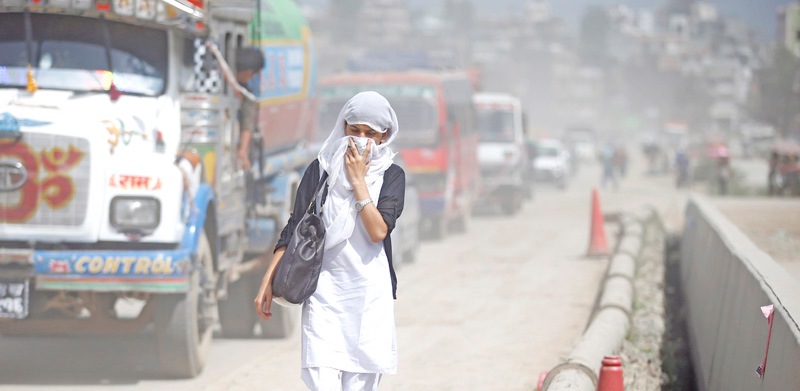Kathmanduites exposed to polluted air face fatal health hazards

By Indira Aryal
Kathmandu, Feb. 20: Despite having a lot of talks and public awareness campaign, air pollution has been growing day-by-day in the Kathmandu Valley. In recent years, air pollution has emerged as a major problem for people, putting health of thousands at risk.
Increasing population and rapid urbanisation are some of the factors polluting the air. Other factors for the growing air pollution, experts say, are increasing number of brick kilns, burning of waste materials and a rise in the number of diesel-run vehicles.
People residing in the valley have been found developing potentially serious health problems due to air pollution, experts said.
When Shyam Sharma, a Bachelor level student of RR Campus, came to Kathmandu in 2015, he was fit and fine. But after two years, he developed sneezing and coughing problems.
He said, “I thought it was nothing, just an allergy.” But, over time he started feeling shortness of breath and went to hospital for a check-up. Doctors at Alka Hospital diagnosed him with allergic asthma. He was advised to stay away from dust and smoke. “Where to go; I have no option but to stay here. I take medicines to prevent further complications,” he said.
Public health expert Dr. Khem Karki said that the scenario was "obviously going to worsen further in the coming years if immediate preventive measures were not taken in time”. Air pollution has long been regarded as a silent killer causing a variety of chronic and infectious diseases.
“It is the time to generate awareness among the common people about the harmful effects of air pollution and take necessary precautions,” Dr. Karki said.
The Constitution of Nepal has also mentioned that a clean and healthy environment should be guaranteed to the people as their fundamental right. To follow the Constitution’s aspiration and keep valley’s pollution under control, the Kathmandu Valley Air Quality Management Action Plan has been tabled in the Cabinet for approval which will come soon, said Acting Director General of the Department of Environment Indu Bikram Joshi.
The air quality in the valley has been deteriorating in the past few years, Joshi said. There are 20 stations across the country to measure air quality; among them only 14 are in operation. The valley’s air quality is the worst, Joshi informed.
Joshi said the trend of purchasing a new vehicle should be discouraged and older public vehicles should be removed from the valley to improve the air quality. Emissions from the vehicles are particularly toxic as diesel-powered vehicles, which are considered deadly and carcinogenic, outnumber the petrol-powered ones here, Joshi informed.
Other causes of air pollution include unplanned expansion of roads, ill-managed dumping sites, and old engine vehicles, said Dr. Karki.
Air pollution in Kathmandu is five times higher than the WHO parameters. The pollution will be in the peak during the winter season and everybody is suggested to wear a mask while walking outside.
According to the World Health Organisation, globally, unhealthy environment causes a total of 12.6 million deaths and air pollution is solely responsible for 7 million deaths annually. Every year, air pollution is linked to around 6.5 million premature deaths globally.
Dr. Karki said that both common ailments like respiratory illness, allergy, and eye infection and chronic diseases like lung cancer, chronic obstructive pulmonary disease (COPD), heart disease, and stroke are increasing at an alarming rate due to air pollution.
A study conducted in 2017 by the Department of Environment showed that the air quality status of Kathmandu Valley, Lumbini and Sauraha was a matter of serious concern. Pokhara Valley is relatively safe in terms of air quality status.
Recent News

Do not make expressions casting dout on election: EC
14 Apr, 2022
CM Bhatta says may New Year 2079 BS inspire positive thinking
14 Apr, 2022
Three new cases, 44 recoveries in 24 hours
14 Apr, 2022
689 climbers of 84 teams so far acquire permits for climbing various peaks this spring season
14 Apr, 2022
How the rising cost of living crisis is impacting Nepal
14 Apr, 2022
US military confirms an interstellar meteor collided with Earth
14 Apr, 2022
Valneva Covid vaccine approved for use in UK
14 Apr, 2022
Chair Prachanda highlights need of unity among Maoist, Communist forces
14 Apr, 2022
Ranbir Kapoor and Alia Bhatt: Bollywood toasts star couple on wedding
14 Apr, 2022
President Bhandari confers decorations (Photo Feature)
14 Apr, 2022











